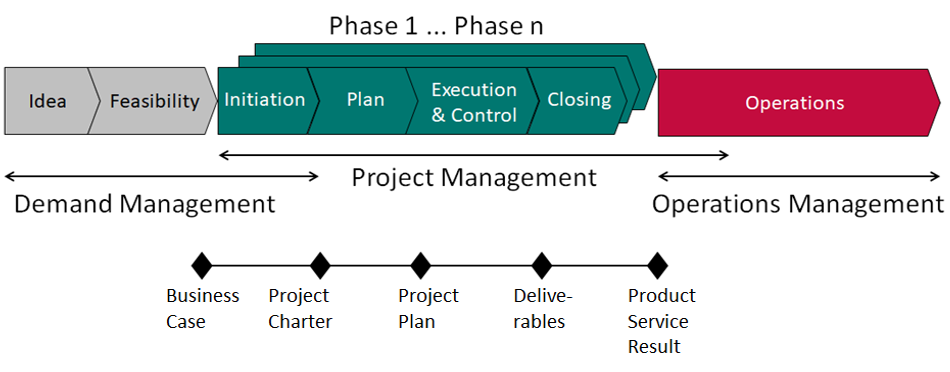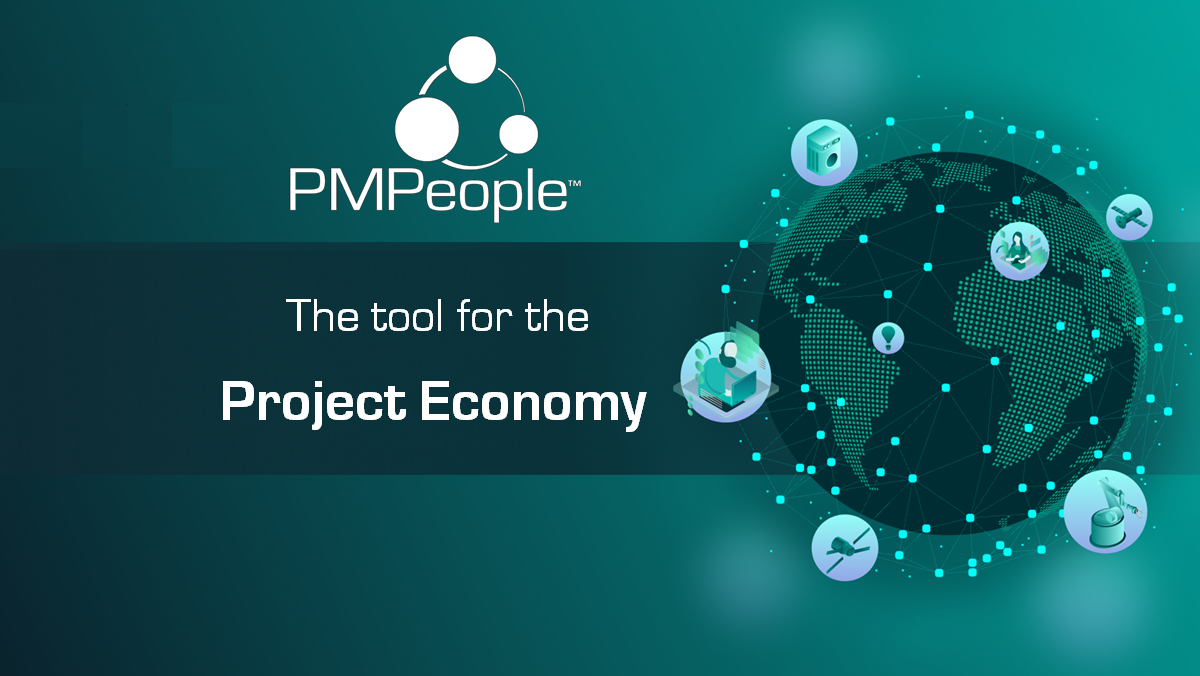There are three main types of management at any organization, be it public or private, profitable or nonprofit:
- Operations Management to optimize resource usage and increase productivity of repetitive tasks, those that keep the business running, pay the payrolls and generate benefits. Operation Management techniques have been practiced and improved since the Industrial Revolution.
- Project Management arose just over half a century ago, when managers realized operation management techniques were not enough to manage projects. A project is a temporary endeavor undertaken to create a unique product, service, or result. This definition applies when making ideas a reality via decomposition into tasks and teamwork. When a project is finished, the product of the project is transitioned to operations.
- Demand Management: Big organizations uses demand management to prioritize possible initiatives candidate to be executed as projects.
Let’s take the example of one of the most important companies today:

- Apple is one of the most important companies in the world thanks to operations management (manufacturing, sales, etc.). All you have to do is to stop by at an Apple Store to check out the health of this business.
- Nonetheless, Apple has become a market leader by transforming ideas into products, mainly thanks to 6 successful projects: the Macintosh Project, the iMac Project, the iPod Project, the iPhone Project, the iPad Project, and the Apple Watch Project. They were not properly managed as projects but programs –a program is a group of related projects managed in a coordinated way to obtain benefits and control not available from managing them individually. Apple’s leading position explanation should also include the lessons learned from failed projects: the Lisa Project (computer), the Newton Project (PDA), the QuickTake Project (camera), etc.
- Although Apple keeps strict secret on next releases, we can assume they invest big money on research and development. They devote expensive teams to demand management, analyzing quite a few number of new initiatives regarding health wearable devices, cloud computing, artificial intelligence, etc. No organization has all resources to execute all projects. They need feasibility studies, cash flow analysis, prioritization, etc.
Three management types can be represented sequentially:

Project Management stands between Demand and Operations Management. Last project phases may overlap with Operations Management: projects frequently include services setup and go-live commissioning and first operations follow-up. Initial project phases usually meets Demand Management: project planning efforts are devoted to rationalize the go/no-go decision. Project Management initiation processes guide us on how to manage a project, even before it is approved.
Large projects can be split into sequential phases. On each closure stage gate, a decision needs to be made to continue or stop the project. Any project or phase can be managed by applying the 5 process groups –initiating, planning, executing, monitoring/controlling and closing. At any project or phase, we can produce documents for the business case, the project charter, the project plan, deliverables and product transition to operations. Intensive planning is only advisable when most requirements are clear since the very beginning of project or phase. This is the case for predictive projects.
Other projects are approved despite most requirements are not clear. They are called adaptive/agile projects. Detailed requirements are elaborated progressively, via continuous collaboration with certain stakeholders.
What do managers really mean when they “empower” us as PM?
The simple, honest answer is: “PM is the one to blame if project fails.”
Managers delegate project management to a professional project manager because they need somebody accountable to achieve the project management goals, mainly those related to schedule and cost management. From a financial perspective, above all things, projects need to finish on time and on budget:

Let’s say Apple is running the project to produce the next version of the iPhone. What is the major concern of Apple top managers? They can only complain of how much the project is costing. While the project in on execution, only negative cash flows are produced. Apple accountants take the project as investments consuming resources, paying third party services, buying assets, expenses, etc. Apple gets positive cash flows after starting operation phase: there will be operation expenditures in factories and stores, but also sales and revenues. Then Apple will be able to validate the business case and make sure that they get the return on investment within the approved timeframe.
Professional project managers are aware of their performance will be evaluated at project closure. If the project was planned to take 10 months but it takes 15, it is a failure. If cost baseline is €500k but actual cost is €800k, it is a failure. The person to blame is the project manager. Blaming a project manager could not be easier. Everyone knows how to count months and euros.
To play knowing the rules, the professional project manager a defensive strategy: before it gets too late, involve stakeholders in the problems and seek the solutions with them. “It is not the Jose’s project, it is the organization’s project”. When problems arise, the question should not be: “What do I need to do as a PM?” The question should be, instead: “What do we do as organization?”
Are you ready?
Companies give more and more value to project management to make ideas a reality. According a recent research by PMI, the number of individuals working in project-based roles will increase from 66 million in 2017 to 88 million in 2027. And the value of economic activity worldwide that is project oriented will grow from $12 trillion in 2013 to $20 trillion in 2027. Companies will employ more and more project management professionals, devoted 100% to manage projects.
These professionals should be able to manage predictive or agile projects, big or small ones. In the project economy, people have the skills and capabilities they need to turn ideas into reality, and organizations deliver value to stakeholders through successful completion of projects, delivery of products, and alignment to value streams. There will be more and more people working 100% on projects; but also less and less fixed job descriptions: people will see how their jobs are redefined from one project to another.
PMPeople: The Tool for the Project Economy
PMPeople stands for people collaborating on project management. PMPeople is the tool for professional collaboration in project management. Organizations need their projects profitable, strategy aligned and value adding. Top managers do not have time to manage each project crisis. Project management should be addressed professionally.
PMPeople gets organizational project maturity to the next level, in an agile way, without changing organizational processes, nor adding bureaucracy. People don’t need to be trained, or getting certified in project management. Costly PMO teams are not needed, either.
PMPeople is aimed to unify professional project management of all kind of projects.
PMPeople is aimed to unify professional project management by these differential points:
- Designed by and for professional project managers, following professional project management standards.
- Online productivity –less meetings, less documents, less workflows– through distributed collaboration among 12 specialized roles: Organization Owner, 6 roles on demand management and 5 roles on supply management.
- Freemium product –unlimited time, unlimited users, only managers have to pay– usable via web and mobile application.
Start using PMPeople for free, for unlimited time and for any number of users. In premium organizations, only managers have to pay 20€ a month. Several roles –stakeholders, team members, sponsors and resource managers– are always free. You can increase or decrease your premium seats according to the organization actual needs. Premium organizations have access to our interactive support through Slack. Our servers are located in EU. This software can also be hosted on customer premises.
Jose Barato
Related posts
Categories
- Business (16)
- Demand Management Roles (14)
- Frequently Asked Questions (7)
- Guide (26)
- People (23)
- Assignments (2)
- Feedback (2)
- Project Team (3)
- Tracking Time And Expenses (2)
- Process (9)
- Closing (2)
- Executing And Controlling (2)
- Planning (1)
- Project Management (67)
- Management Frameworks (18)
- Organization Owner (OO) (3)
- Project Economy (54)
- Tools (19)
- Supply Management Roles (5)
- Training (6)
- Uncategorized (1)




